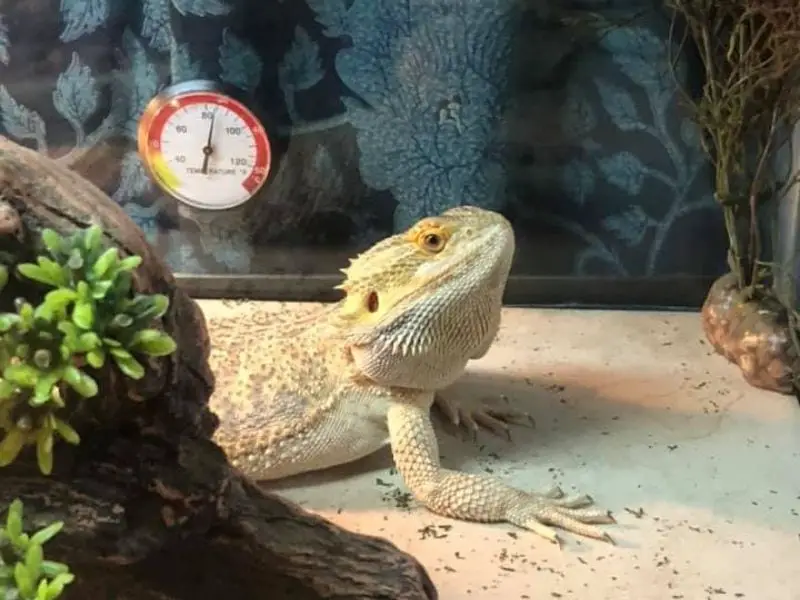Bearded dragons are cold-blooded animals and need specific heating in order to regulate their body temperature. These reptiles have a low tolerance for temperature changes and can go into shock if not properly heated. So, how long can bearded dragons go without heat?
How long can bearded dragons go without heat?

Bearded dragons can survive for up to 24 hours without heat when the temperature is at least 65°F. If the lizard goes long without an external heat source, it will become inactive and its digestion slows down significantly.
Bearded dragons require a heating mechanism in their enclosure to regulate their body temperature. The best way of providing heat is with a ceramic heat emitter or a UVB bulb.
I’ve discussed different ideas on providing heat for your bearded dragon even when there’s a power outage below. With these tips, you can keep your reptile pet warm and active even when the temperature drops in the winter and during a power outage.
Will a bearded dragon die if it gets cold?
Bearded dragons rely on external heat sources to remain active and perform their bodily functions. Without heat for more than 24 hours, the vital bodily processes of the reptiles will be disrupted. The bearded dragon will die from too much cold and the inability to move and eat.
This process can take between 24 hours and a few days, depending on the situation, place, or general climatic conditions. In an arid habitat with little to no vegetation, it might take about 24 hours for the animal to die from exposure to extreme cold for a long time.
However, if your lizard lives at higher elevations with more shielding from wind gusts and precipitation, this timeline could increase by up to two days. The bottom line – is don’t leave your pet bearded dragon at home alone for too if you’re expecting extreme conditions.
What is the lowest temperature a bearded dragon can survive?
The lowest temperature bearded dragons can survive for a short period is about 65°F. When it drops below 65°F, the lizard will show inactivity and lethargy due to the extreme cold. If not provided with heat, the lizard will be at risk.
Bearded dragons may refuse to eat if their body temperature drops too low, as they suffer from indigestion and compaction. You might want to wait until their body warmth has adjusted back up after exposure to warmer conditions before they start eating normally again.
For bearded dragons to thrive properly in captivity, they need an appropriate amount of UVB light and heat sources in their enclosure – otherwise known as heating rocks and/or lamps. The best way to care for a baby bearded dragon is to provide the right temperature in the tank to prevent the risk of extreme cold.
The ideal ambient air temperature range is 75-85° F with basking spots of 90-95° F.
READ ALSO: Bearded Dragon Laying Flat: Causes and Fixes
Why do bearded dragons need heat?
Warmth is very important for any cold-blooded animal. Like all reptiles, bearded dragons depend on external heat sources to regulate their body temperature. This is why you should provide a basking spot and a cooling spot in the beardie’s enclosure.
The basking spot on a bearded dragon’s tank should be between 85-90 degrees Fahrenheit, and the ambient air in the cage needs to stay at 82-86 degrees. A thermometer is essential for monitoring your bearded dragon temperature to ensure they remains healthy.
But what is the importance of heat other than helping the reptiles regulate their body temperature?
1. Digestion
In order to digest food, a bearded dragon needs heat. The warmth of the heat source promotes good bacteria in your pet’s gut that help with digestion. Giving them some time on their basking spot after eating can also prevent indigestion and constipation.
Most beardies will stay on a heating pad or rock after feeding to heat up their gut. If they don’t get heat, your pet could experience various unpleasant digestive problems such as constipation and bloating.
Signs of indigestion in bearded dragons include:
- missing or reduced appetite
- lethargy, sluggishness, or being inactive
- regurgitation of food
- circling behavior around the heat source
It’s important to monitor the heat around your bearded dragon at all times, especially during the winter months, in order for them to digest food properly.
2. Regulation of body temperature
Bearded dragons need warm areas in their enclosure to help regulate their body temperature. If your pet does not have a basking spot, it may become too cold and sick.
The regulation of the bearded dragon’s body temperature is what allows them to live an active lifestyle outdoors with relatively low food requirements – which is why it’s so important to provide heat for these reptiles.
If you find that your beardie has problems regulating its internal body temperature, the heat pad may not be working. Check the heat lamp and ceramic pads for night heating to ensure they’re getting power and providing heat as expected.
Winter months are the most sensitive and your beardie will most likely go into brumation. If your bearded dragon isn’t provided with enough heat at night or during the winter months, then its internal temp will drop, leading to lethargy and even death if left unchecked.
In order to prevent regulation problems due to lack of proper heating, you should:
- Provide an appropriate basking spot
- Check to make sure the heating appliances are working as required
- Provide a backup power source during power outages
3. Calcium absorption
Dietary calcium absorption in bearded dragons also relies on heat. Bearded dragons need heat in their enclosure to help them digest food and absorb calcium properly.
Without proper heating, your bearded dragon may experience problems related to calcium absorption from its diet. Ensure there is sufficient heat where he can sit on his basking spot and bask when needed. Also, make sure food intake from prey items provides an ample supply of dietary calcium as well.
If they aren’t getting enough calcium from their diet, it could be because their heat sources aren’t producing enough heat. Over time, you may end up with a sickly pet and an increased risk of health problems caused by cold temperatures, like poor digestion and constipation.
Signs of low calcium in bearded dragons include:
- poor appetite
- Metabolic bone disease
- lethargy, sluggishness or inactive
- swollen joints and bones that may be deformed due to the lack of heat.
READ MORE: Calcium for Bearded Dragons: How Much they Need + Frequency
Power Outage and Heating for Bearded Dragons

Power outages can be fatal for bearded dragons if you’re unprepared. Be sure to have a secondary heating source before an outage occurs.
Here are alternative ways to provide heat for your bearded dragon when there’s a power outage:
Bask the lizard in the sun
In case of a power outage with no backup power source, taking the lizard outside to bask in the sun is a great way to provide warmth. However keep an eye on the bearded dragon and stay close by if they need help getting back inside or you want to retreat from the sun when it’s too hot outside.
Bearded dragons obtain their warmth in the wild by basking in the sun. Taking your bearded dragon outside to bask in the sunlight will provide them with warmth as well as vitamin D.
You can also place the lizard near any heat source, like an open window where sunshine is coming through or close to something that emits heat, such as a space heater.
Have backup power sources
If it’s possible, have a solar backup and battery backups for your bearded dragon.
- solar: when the sun is out, you can place solar panels in an area where they will receive direct sunlight or use solar-powered lamps that plug into outlets to provide heat while there are no power
- batteries: if you don’t want to go with solar, battery-powered heating pads are a more cost-effective option.
It is important for your bearded dragon to have heat, especially when it’s cold outside or during winter.
Use blankets
Another way to keep your bearded dragon warm without electricity is by using blankets.
You can place blankets over the tank or on top of your lizard to provide warmth and help stimulate them, so they know it’s time for a meal.
Be careful not to use too many blankets because this will trap in the heat and suffocate your bearded dragon. You only need enough blankets without covering up any vents under tanks or anywhere else where air needs gets in.
Extra blankets should only be used if you have an emergency power outage with no other backup source available. Don’t risk trapping in all of the body heat given off by the animal since this could result in death.
Hold the bearded dragon close to your body
If you have no other way of providing heat for your bearded dragon, then the best option is to hold them close to you.
This will help provide warmth and give them a sense of security while they’re cold from being inside all day or feeling exposed if there’s an power outage with no backup source available.
This should only be done as a last resort because it can’t be guaranteed how long their body temperature will stay warm and any sudden movements could result in injury or death so keep the contact gentle but consistent.
Avoid holding the lizard too tightly since this might hinder blood flow which would make the animal more prone to getting sick. Also, be careful of their tail which could break off if it’s not gripped gently or when they’re jumping around from being scared.
Use a hot water bottle
If all the above methods seem unsafe for whatever reason, try using a hot water bottle wrapped in cloth on one side only so that it won’t overheat when lying against it during use.
You want to ensure the hot water bottle does not overheat the bearded dragon, as it can easily do so. You can use a thermometer to check the temperature before setting it next to the bearded dragon. Also, to ensure you need to adjust the temperature of your hot water bottle.
Finally, never use a light bulb or anything that is too exposed for your pet, as this can be dangerous for the lizard. You want to make sure they don’t get too close or touch anything that emits heat, such as lights because these are not safe options.
Signs your bearded dragon is too cold
Extreme heat is too risky for bearded dragons and can lead to many health complications. If you are keen on your bearded dragon’s behavior, you will notice if the reptile suffers from extreme cold.
Here are the signs your bearded dragon might be too cold:
Immobility
If your bearded dragon appears immobile, it’s too cold. This can happen when the reptile is not moving and/or staying in one place. These are two of the main signs of a sick or stressed-out animal: any sudden change to their habits could mean something is wrong.
Unresponsiveness
If your bearded dragon is not responsive, it’s too cold. Bearded dragons are generally active animals that move around to avoid anything they don’t like or find uncomfortable. If the reptile becomes unresponsive, then chances are he/she needs more heat immediately.
Low skin temperature
If your bearded dragon has a low skin temperature, it’s too cold. If you touch the reptile and it feels cool to the touch or dry, they are probably not getting enough heat.
READ NEXT: Do Bearded Dragons Absorb Water Through Their Skin?
